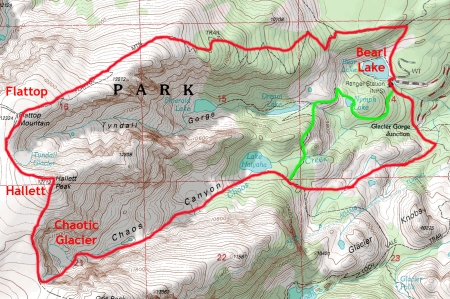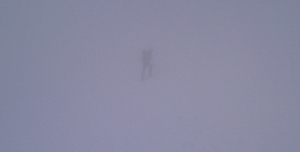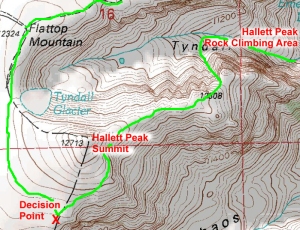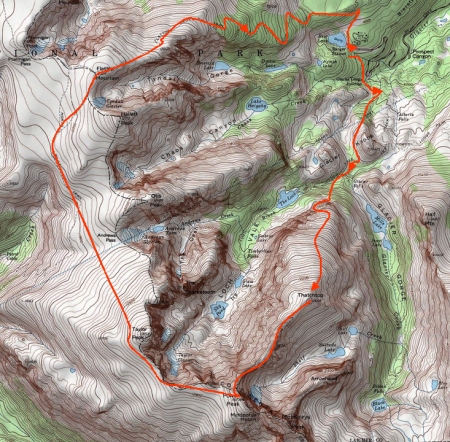May 14, 2011
The weather forecast was iffy for snow climbing…rain/snow after noon with higher temps. We chose Flattop Mountain to give ourselves some options for choosing a descent after we see the conditions. My guess was for Brian to drop down from the Flattop summit toward Notchtop via the Ptarmigan Glacier into Odessa Gorge and then circle back to Bear Lake via Lake Helene trail to Fern Lake trail to the bottom portion of Flattop Mountain trail. I liked having the option of simply returning via the Flattop trail. Of course, my personal decision would be based on how I felt, the weather conditions, and the condition of the snow.
Brian picked me up at 5:30am and we headed up to Estes Park…for the 3rd weekend in a row. As we drove up, a solid wall of dark clouds blocked our view of the mountains….and even extended down to the tops of the foothills. It was not going to be a nice day. But that was okay; I came for the exercise.
The closer to RMNP and the higher we got, the darker the sky became; at the same time, we could tell the temperature was unusually warm.
Hello Spring.
Eventually, we got high enough to reach the cloud bank; we were driving inside a cloud. As we neared the Bear Lake parking lot in RMNP, we could see, to our surprise, that there were blue skies above the cloud bank. Suddenly we realized that we were going to get a lot of sun, at least until the after noon weather arrived.
As we pulled into the parking lot, Hallett Peak looked as beautiful as I have ever seen it. And, once out of Brian’s truck, we could tell there was not a bit of wind for the first time in the 2011 season.
The plan for the ascent was to skirt Bear Lake (9450′) which sits at the mouth of Tyndall Gorge, taking the Flattop Mountain Trail for 4.4 miles to the top of Flattop Mountain. The trail ascends the long north slope of Flattop that rises between Tyndall and Odessa Gorge.
We started up around Bear Lake at 7am…the snow was perfectly frozen hard, somehow. My snowshoes were needed to grip the trail, not float on the snow. We made great time. I felt good enough that I took the lead and kept up a fast pace all the way to tree line without a break. It was hot as Summer. At tree line, we stopped to put on sunscreen and admire the solid bank of cloud cover below us. I had only ever seen it once before.
It was a spectacular day: blue sky, warm temp, no wind.

The great views from Hallett Peak. Longs Peak is the big peak pictured; the fog below can be seen to the left.
As we neared Flattop’s summit @9am, we decided to keep going to Hallett Peak, 1/2 mile and 500′ of elevation gain away.
Hallett Peak (12,713′) sits on the Continental Divide between Tyndall Gorge (on the north) and Chaos Canyon (on the south).
I arrived first, for a change; Brian had to stop to remove & put away his skis, and I kept going in a fit of competitive furor. I cannot remember the last time I beat Brian to a summit. The Spinning continues to deliver a high level of fitness.
It was only 9:45am, but I decided to eat my lunch. I wasn’t hungry as much as I couldn’t think when I’d have another chance. It didn’t seem fair to have to wait until returning to the car.
Even on Hallett’s summit there was no wind. Brian spoke of the conditions being perfect for spray painting….absolutely zero wind. It was truly spectacular.
After the obligatory summit photos, I asked Brian how he was planning to descend. He shocked me by saying he was going down Chaos Canyon.
I had zero interest in that Chaos Canyon. But Brian did make a good point when he said we needed to use these perfect days to try new things. I wavered.
I got up and walked toward Otis Peak so I could see the Chaos Canyon and Chaotic Glacier which links the canyon to Flattop.
The glacier looked steep; I thought ‘no’….too dangerous without an ice axe. But then I remembered Brian’s comment and got back on the fence. I wanted to find a way to agree, but I didn’t want to die being stupid.
I moved back to Hallett’s summit where Brian and my gear were awaiting my decision. I said that I wanted a closer look before deciding.
We hiked down the southern side of Hallett; I took particular note of how firm the snow was on that side. Once I could see more of Chaotic Glacier, I could see that it was way too steep if the snow was hard. No way. I said out loud that it would be plain stupid for me to descend something that steep with nothing to arrest my slide. Brian gave me hope by offering to let me use one of his ski poles that had a plastic pick extending from the handle.
I agreed to continue to the top of the glacier to see how the snow felt. If the snow was hard, I planned to turn back toward Flattop and descend the way we came up.
Once we reached the glacier at approximately 11am, the snow felt promising. It was soft in spots, sometimes as deep as 6-8 inches; I decided I would descend Chaotic Glacier and then hike out Chaos Canyon to Emerald Lake and back to Bear Lake. I had never descended that way before; it would be an adventure!
I traded Brian for one of his poles, per his earlier offer. After fiddling around with the two poles, I decided that I would be better served with just the pole with the pick. I figured that if I really needed to self-arrest, I was likely to drop both poles if I was fumbling around with two. Then we walked together down the top of the glacier to reach the part where the slope increased dramatically. Too dramatically. And, the steeper snow was not soft.
Was I really going to do this? Crap.
The angle was terrible, but there were no obstructions below. Even if I lost control, I wouldn’t hit anything. At worst, I’d get injured. But I didn’t want to get injured.
What was I thinking? Okay, I would do it.
Brian started down and stopped after skiing about 50 feet to wait for me to start down. I sat in the snow and got used to the new pole. I envisioned how I’d use the pick to self arrest and did a practice roll over. The pick was made of plastic and so was made thick so not to break. The thick material didn’t want to sink into the snow and so the pick tended to roll to the side when I weighted it. Crap.
I couldn’t do it. Could I?
Damn.
I tried going down face in with both hands on the pole with the pick buried. It was working! I was able to get the toes of my boots into the snow and then reposition the pick lower, and then repeat. As long as the snow didn’t become frozen at some point below me, I would live. But now I was committed. And that’s when it occurred to me that the pick could break-off at any moment. These poles were 10 years old and made of plastic. If it broke, I was going for a long, fast slide.
But I got lucky. The lower I got, the softer the snow became. I would live…with my parts unbroken.
I decided the snow was soft enough to glissade, and so I turned around to begin. Suddenly, I couldn’t see anything.
The cloud bank beneath us had rolled up the canyon and now completely obscured our vision. It is not a good idea to start sliding down steep snow without being able to see what I might hit or fall into.
I’d just have to trust that my last view of the glacier, which showed nothing to worry about, was accurate. And, so I started. Down I went….woohoo! And then it was over. I made it.
But now we couldn’t see anything about where to go. If we had to rely on simply going downhill, it was going to be a hard escape.
Then I noticed the tracks again. I could follow the tracks. And, if these folks could see where they were going when the hiked out, then the tracks would lead us out.
Down and down, we followed the tracks down Chaos Canyon and past Lake Hayhafa. Visibility as still poor, but I figured we just had to keep following the tracks out toward Dream Lake, which was the only exit from Chaos Canyon, right? Keep reading.
Once past Lake Hayhafa, the terrain looked less and less trail-like. After some distance of plunging through tree branches where sunglasses were necessary as protection from poking, Brian stopped and said, “do you know where we are?”
I said I did not, but indicated that I assumed that the tracks had to lead to Dream Lake. Brian then said, “well, we’ve been heading right (south) instead of left (north) for a while now….I think we are headed toward Glacier Gorge.”
Glacier Gorge! He might as well have said ‘The Moon’.
I said I didn’t think it was possible to go to Glacier Gorge from Chaos Canyon. Brian said he didn’t think so either, but that where he thought we were going, possible or not.
We looked around and couldn’t see anything beyond 100 yards. We certainly had no way to see any landmarks to guide us. We were screwed.
Then I remembered that I had brought my smartphone, and that I might be able to figure out where we are…if I could get a satellite signal.
It worked. Of course the screen was almost entirely unreadable in the weird light conditions, and Google Maps is not designed for optimum readability on tiny screens. But I was able to make out that we had indeed been heading SSW, toward Glacier Gorge. I pointed toward Dream Lake and then Bear Lake. Brian didn’t think turning north toward Bear Lake would work as there could be cliffs and other obstacles between it and us. We either had to backtrack or continue toward Glacier Gorge and hope we could find a path to join-up with the winter trail next to The Knob.
The Knob seemed to be the easiest choice, but, even if it was successful, we’d have to loop back to Bear Lake. Crap.
For some reason, we stayed with the tracks that had led us to the middle of nowhere, but the tracks did seem to head in approximately the right direction. Heck, either they made it or we’d find their frozen bodies along the way.
Another 30 minutes in and our situation hadn’t improved. I decided it was time for another direction check. We were still in the middle of nowhere. And, then I noticed that my battery was about to die. I gave Brian a heading and then we stayed with it until we finally joined up with the well-established trail.

Our approximate route looping from Bear Lake to Flattop to Hallett toward Otis and then down Chaotic Glacier and Chaos Canyon, where we got lost. The line east from Chaos Canyon does not reveal the unpleasant wandering involved in such a bushwack.
We plodded along, happy to know where we were for the first time in a while. By 1:30pm we reached the Bear Lake parking lot. It was over. We had taken 6.5 hours to hike approximately 11 miles while gaining and losing 3200′ plus a 100-250′ needed to wander from Chaos Canyon to the Glacier Gorge Winter trail and back up to Bear Lake.
On the drive home, Brian told me about a tale he heard from a fellow who took a bad fall skiing down Lambs Slide. This fellow used the same poles as Brian, with the plastic picks. When he fell on Lambs Slide, both picks broke off, sending him to serious injury.
It is plain stupidity for me to fail to bring an ice axe when venturing high in the mountains, especially given my apparent inability to refuse an opportunity for adventure. I’ll not forget again.
Another great day in RMNP!

















